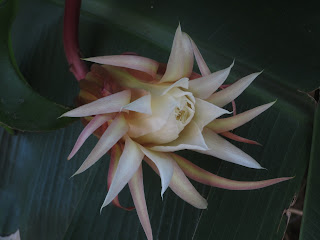I was attempting to raise strawberries in the one small patch of yard which would receive enough sun (I thought) that they would thrive. I was weeding and removing yellow leaves. Something suddenly moved and I saw a medium size snake that made me panic. I had a trowel in my hand I used to 'defend' myself.
Afterwards looking at the destruction I had done, I was ashamed. I knew it was a non-venomous snake, not threatening me in any way, other than being in the wrong place (to my mind) at that point in time.
I have had relationships with reptiles in my younger years. I grew up near Pennypack Park in Northeast Philadelphia. My parents indulged my pet gathering forays into the park. Over the years we shared the house with Box Turtles, Rabbits (domestic, not wild), Snapping Turtles, and snakes.
The biggest snake we lived with was a Black Rat Snake. It belonged to Roger Conant who was then Curator of Reptiles at the Philadelphia Zoo. He had loaned it to the Nature Lodge at Treasure Island Boy Scout Camp for the summer. As one of the counselors, I was returning it to him at the end of the season. The morning he came to retrieve it, the snake had made a break for it. I was scouring the house until I heard my yelling in the basement. It had hitched a ride in the laundry basket and was daring my mother to remove the dirty socks from the basket. Mr. Conant was very gracious as he retrieved his snake. Thankfully, it was the last summer that the Nature Lodge kept wild animals in captivity.
But back to our container garden on Baltimore Ave.
This was our first sidewalk snake discovered in the Hydrangeas in 2009. It was sunning itself, which I now know is something reptiles do after they have eaten to help the digestive process. I presumed the snake had slithered over from our neighbors actual garden. Their yard has minimal sun, so I thought it would later return to 'land'. Didn't see it again that summer, but the following year, I did find a shed snake skin in a nearby pot. the skin was from a snake about 14 inches long. Given these snakes coloration, it's easy to overlook them in the leaf litter and dry soil at the base of your plants.
Last November about Thanksgiving weekend, we cut back our pots of Canna and brought them inside to our back basement. It's a space we seldom enter over the winter, separate from the basement where Gary has his glass studio. As we were cleaning up the leaves which accumulate behind the pots, I noticed several wriggling things. I expected them to be worms, as the material is often damp and beginning to decompose. I was surprised that the movement was not the erratic movement of disturbed worms, but more rhythmic and intentional. I looked closer and realized they were baby snakes. I carefully moved the pots back in place that would remain outside all winter, hoping we would greet them again in the spring.
On May 9 I was cleaning up the side deck, where a bunch of empty pots had wound up in the ledge we incorporated in the side deck's design. I was separating and then sizing the, when something caught my eye. It was this critter. Larger than the snakes we had seen in November by at least double, but no where near as large as the snakes we were seeing later during the summer.This snake retreated into the space between the nested pots and I had a sudden revelation.
When I prepare new containers to use in our garden, one thing I usually do is make sure there is a layer of air pockets at the bottom of the pot. I also make sure there are adequate drain holes at the lowest point in the container. The easiest and handiest way to do this is to use fragments of nursery trays, or those flimsy plastic market packs crushed to improve drainage. Why do I do this? Plant roots need to absorb oxygen as well as water. If the soil becomes over-saturated, the roots can drown. This is probably the least understood concept for beginning gardeners. By providing a layer of air holes by using broken pots or other material, you help make sure this doesn't happen to your plants. These air pockets seem to have an added benefit in our sidewalk garden. they provide a suitable environment for a snake community.
Why are we so enthusiastic about these critters? Two words-Pest Control! Brown Snakes snakes eat slugs for one thing, a pest we have in abundance. I have tried the stale beer control, but you wind up with saucers of real disgustingness which is almost as gross as the damage slugs do themselves. I'll choose snake control over beer control any day. If there is a drawback, it is that they eat earthworms. I haven't noticed a decline in that population, tho. Especially in our compost bins.
Female Northern Brown Snake retain their fertilized eggs internally which develop through the spring and summer. The young are born live in late summer/early fall. These snakes have their own predators to evade. I'll tell you about our life with some of them in a future post.

























